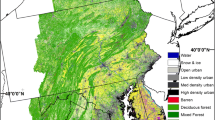Abstract
Landscape structure in a forest mosaic changes with spatial scale (i.e. spatial extent) and thresholds may occur where structure changes markedly. Forest management alters landscapestructure and may affect the intensity and location of thresholds. Our purpose was to examine landscape structure at different scales to determine thresholds where landscape structure changes markedly in managed forest mosaics of the Appalachian Mountains in the eastern United States. We also investigated how logging influences landscape structure and whether these management activities change threshold values. Using threshold and autocorrelation analyses, we found that thresholds in landscape indices exist at 400, 500, and 800 m intervals from the outer edge of management units in our studyregion. For landscape indices that consider all landcovercategories, such as dominance and contagion, landscape structureand thresholds did not change after logging occurred. Measurements for these overall landscape indices were stronglyinfluenced by midsuccessional deciduous forest, the most commonlandcover category in the landscape. When restricting analysesfor mean patch size and percent cover to individual forest types,thresholds for early-successional forests changed after logging. However, logging changed the landscape structure at small spatialscale, but did not alter the structure of the entire forestmosaic. Previous forest management may already have increasedthe heterogeneity of the landscape beyond the point whereadditional small cuts alter the overall structure of the forest. Because measurements for landscape indices yield very differentresults at different spatial scales, it is important first toidentify thresholds in order to determine the appropriate scalesfor landscape ecological studies. We found that threshold andautocorrelation analyses were simple but powerful tools for thedetection of appropriate scales in the managed forest mosaicunder study.
Similar content being viewed by others
References
Balcom, B. J. and Yahner, R. H.: 1995, ‘Microhabitat and landscape characteristics associated with the threatened Alleghenywoodrat’ ,Conserv. Biol. 10, 515–525.
Baker, W. L. and Cai, Y.: 1992, ‘The r.le programs for multiscale analysis of landscapestructure using the GRASS geographical information system’ ,Landscape Ecol. 7, 291–302.
Baker, W. L.: 1994, ‘The r.leprograms: A set of GRASS programs for the qauntitative analysis of landscape structure’, R.le manual, University of Wyoming, Laramie, Wyoming.
Baker, W. L.: 1992, ‘The landscape ecology of large disturbances in the design and management of nature reserves’,Landscape Ecol. 7, 181–194.
Cliff, A. D. and Ord, J. K.: 1981, Spatial Processes: Models and Applications, PionLimited, London.
Danielson, B. J.: 1991, ‘Communities in a landscape: The influence of habitat heterogeneity on the interaction betweenspecies’ ,Am. Nat. 138, 1105–1120.
Delattere, P., Giraudoux, P., Baudry, J., Quéré, J. P. and Fitchet, E.: 1996, ‘Effect oflandscape structure on common vole (Mycrotus arvalis) distribution and abundance on several space scales’ ,Landscape Ecol. 11, 279–288.
ERDAS: 1997, ERDAS Field Guide, 4th ed., ERDAS, Inc., Atlanta, Georgia.
Franklin, J. F. and Forman, R. T. T.: 1987,‘Creating landscape patterns by forest cutting: Ecological consequences and principles’ ,Landscape Ecol. 1, 5–18.
Gardner, R. H., Milne, B. T., Turner, M. G. and O'Neill, R. V.: 1987, ‘Neutral models for the analysis of broad-scale landscape pattern’ ,Landscape Ecol. 1, 19–28.
George Washington National Forest: 1993, Final Revised Land and Resource Management Plan, Forest ServiceSouthern Region, U.S. Department of Agriculture, Roanoke, Virginia.
Hermann, K. A. (ed.): 1996, The Southern Appalachian AssessmentGIS Data Base CD ROM Set, Southern Appalachian Man and the Biosphere Program, Norris, Tennessee.
Holling, C. S.: 1992, ‘Cross-scalemorphology, geometry, and dynamics of ecosystems’ ,Ecol. Monogr. 62, 447–502.
Knick, S. T. and Rotenberry, J. T.: 1995,‘Landscape characteristics of fragmented shrubsteppe habitats and breeding passerine birds’ ,Conserv. Biol. 9, 1059–1071.
Krummel, J. R., Gardner, R. H., Sugihara, G., O'Neill, R. V. and Coleman, P. R.: 1987, ‘Landscape pattern in a disturbed environment’,Oikos 48, 321–324.
Legendre, P. and Fortin, M.-J.: 1989, ‘Spatial pattern and ecological analysis’ ,Vegetatio 80,107–138.
Legendre, P. and Vaudor, A.: 1991, The R Package: Multidimensional Analysis, Spatial Analysis, Département deSciences Biologique, Université de Montréal, Montréal.
Leimgruber, P.: 1998, ‘Landscape ecology of small mammals and songbirds in amanaged forest mosaic of the Appalachian Mountains’ ,Dissertation, University of Oklahoma, Norman, Oklahoma.
Levin, S. A.: 1992,‘The problem of pattern and scale in ecology’ ,Ecology 73, 1943–1967.
MacArthur, R. H. and MacArthur, J. W.: 1961, ‘Onbird species diversity’ ,Ecology 42, 594–598.
MacGarigal, K. and McComb, W. C.: 1995, ‘Relationships between landscapestructure and breeding birds in the Oregon coast range’ ,Ecol. Monogr. 65, 235–260.
Meentemeyer,, V. and Box, E. O.: 1987,‘Scale Effects in Landscape Studies’, in M. G. Turner (ed.), Landscape Heterogeneity and Disturbance, Springer-Verlag, New York, pp. 15–34.
Miller, J. R., Schulz, T. T., Hobbs, N. T., Wilson, K. R., Schrupp, D. L. and Baker, W. L.: 1995, ‘Changes in thelandscape structure of a southeastern Wyoming riparian zone following shifts in stream dynamics’ ,Biol. Conserv. 72, 371–379.
Mills, G. S., Dunning Jr., J. B. and Bates, J. M.: 1991, ‘The relationship between breeding bird density and vegetation volume’,Wilson Bull. 103, 468–479.
Mladenoff, D. J., White, M. A., Pastor, J. and Crow, T.: 1993, ‘Comparing spatial pattern inunaltered old-growth and disturbed forest landscapes’ ,Ecol. Appl. 3, 294–306.
Naiman, R. J., Décamps, H. and Pollock, M.:1993, ‘The role of riparian corridors in maintaining regional biodiversity’ ,Ecol. Appl. 3, 209–212.
O'Neill, R. V., Krummel, J.R., Gardner, R. H., Sugihara, G., Jackson, B., L. Angelis, D., Milne, B. T., Turner, M. G., Zygmunt, B., Christensen, S.W., Dale, V. H. and Graham, R. L.: 1988, ‘Indices of landscape pattern’ ,Landscape Ecol. 1, 153–162.
Pearson, S. M.: 1993, ‘The spatialextent and relative influence of landscape-level factors on wintering bird populations’ ,Landscape Ecol. 8, 3–18.
Phillips, D. L. and Shure, D. J.: 1990, ‘Patch-size effects on early succession in Southern Appalachian forests’ ,Ecology 7, 204–212.
Pogue, D.W.: 1998, ‘A Multiscale Analysis of Factors Influencing the Distribution of Birds in the Southern Great Plains’ ,Dissertation, University of Oklahoma, Norman, Oklahoma.
Pulliam, H. R.: 1988, ‘Sources, sinks, and population regulation’ ,Am. Nat. 132, 652–661.
Sneath, P. H. A. and Sokal, R. R.: 1973, Numerical Taxonomy, W. H. Freeman and Co., San Francisco, California.
SouthernAppalachian Man and the Biosphere: 1996, The Southern Appalachian Assessment: Summary Report, Southern Appalachian Man and the Biosphere Program, Norris, Tennessee.
Spies, T. A., Ripple, W. J. and Bradshaw, G. A.: 1994, ‘Dynamics and pattern of a managedconiferous forest landscape in Oregon’ ,Ecol. Appl. 4, 555–568.
Turner, M. G.: 1987, ‘Landscape heterogeneity and net primaryproduction in the Georgia landscape: 1935–1982’ ,Environ. Manage. 11, 237–247.
Turner, M. G.: 1990, ‘Spatial and temporalanalysis of landscape pattern’ ,Landscape Ecol. 4, 21–30.
Turner, M. G., O'Neill, R. V., Gardner, R. H. and Milne, B. T.: 1989,‘Effects of changing spatial scale on the analysis of landscape pattern’ ,Landscape Ecol. 3, 153–162.
Turner, M. G. and Gardner, R.H.: 1990, ‘Quantitative Methods in Landscape Ecology: An Introduction’, in M. G. Turner and R. H. Gardner (eds), Quantitative Methods in Landscape Ecology: The Analysis and Interpretation of Landscape Heterogeneity, Springer-Verlag, New York, pp. 3–14.
Turner, S. J., O'Neill, R. V., Conley, W., Conley, M. R. and Humphries, H. C.: 1990, ‘Pattern and Scale: Statistics for LandscapeEcology’, in M. G. Turner and R. H. Gardner (eds), Quantitative Methods in Landscape Ecology: The Analysis and Interpretation of Landscape Heterogeneity, Springer-Verlag, New York, pp. 17–49.
Turner, M. G., Hargrove, W. W., Gardner, R. H. and Romme, W.H.: 1994, ‘Effects of fire on landscape heterogeneity in Yellowstone National Park, Wyoming’ ,J. Veg. Sci. 5, 731–742.
USA-CERL: 1991, ‘GRASS 4.0 User's Manual’, U.S. Army Corps of Engineers Construction Engineering Research-Laboratory, Champaign, Illinois.
Ver Hoef, J. M. and GlennLewin, D. C.: 1989, ‘Multiscale ordination: a method of detecting patterns at several scales’,Vegetatio 82, 59–67.
Wiens, J. A.: 1989, ‘Spatial scaling in ecology’ ,Funct. Ecol. 3, 385–397.
Author information
Authors and Affiliations
Corresponding author
Rights and permissions
About this article
Cite this article
Leimgruber, P., McShea, W.J. & Schnell, G.D. Effects of Scale and Logging on Landscape Structure in a Forest Mosaic. Environ Monit Assess 74, 141–166 (2002). https://doi.org/10.1023/A:1013881319390
Issue Date:
DOI: https://doi.org/10.1023/A:1013881319390




